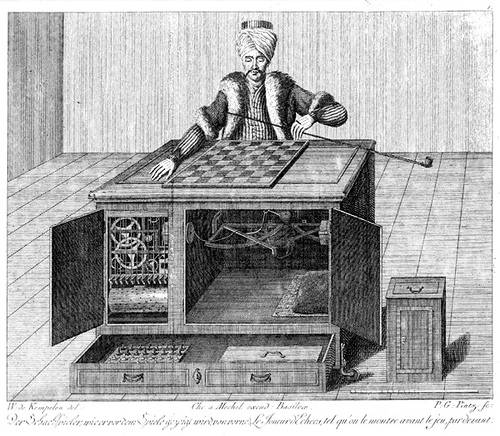
It’s only a happy accident that our moon “fits” over the sun’s disc during a solar eclipse. The sun is 400 times the diameter of the moon, but it’s nearly 400 times farther from Earth, so to us the two have almost exactly the same angular size.

It’s only a happy accident that our moon “fits” over the sun’s disc during a solar eclipse. The sun is 400 times the diameter of the moon, but it’s nearly 400 times farther from Earth, so to us the two have almost exactly the same angular size.
From Anomalies and Curiosities of Medicine by George M. Gould and Walter L. Pyle, 1896:
A convict at Brest put up his rectum a box of tools. Symptoms of vomiting, meteorism, etc., began, and became more violent until the seventh day, when he died.
After death, there was found in the transverse colon, a cylindric or conic box, made of sheet iron, covered with skin to protect the rectum and, doubtless, to aid expulsion. It was six inches long and five inches broad and weighed 22 ounces.
It contained a piece of gunbarrel four inches long, a mother-screw steel, a screw-driver, a saw of steel for cutting wood four inches long, another saw for cutting metal, a boring syringe, a prismatic file, a half-franc piece and four one-franc pieces tied together with thread, a piece of thread, and a piece of tallow, the latter presumably for greasing the instruments.
“On investigation it was found that these conic cases were of common use, and were always thrust up the rectum base first,” the authors explain. “In excitement this prisoner had pushed the conic end up first, thus rendering expulsion almost impossible.”

People were willing to believe in a chess-playing automaton as early as 1769. That’s when Wolfgang von Kempelen unveiled “The Turk,” a cloaked and turbaned robot that played over a maplewood cabinet full of clockwork. The contraption toured the courts of Europe, where it beat Benjamin Franklin and Charles Babbage, among many others.
The machine’s secret emerged only in 1854, after the automaton was destroyed in the great Philadelphia fire. The cabinet had contained a human player who followed the game by watching magnets on the board’s underside. He made his moves on a secondary board that transmitted them to the Turk.
Still, it played some good games. Here it beats the crap out of Napoleon Bonaparte, who has White:
1. e4 e5 2. Qf3 Nc6 3. Bc4 Nf6 4. Ne2 Bc5 5. a3 d6 6. O-O Bg4 7. Qd3 Nh5 8. h3 Bxe2 9. Qxe2 Nf4 10. Qe1 Nd4 11. Bb3 Nxh3+ 12. Kh2 Qh4 13. g3 Nf3+ 14. Kg2 Nxe1+ 15. Rxe1 Qg4 16. d3 Bxf2 17. Rh1 Qxg3+ 18. Kf1 Bd4 19. Ke2 Qg2+ 20. Kd1 Qxh1+ 21. Kd2 Qg2+ 22. Ke1 Ng1 23. Nc3 Bxc3+ 24. bxc3 Qe2# 0-1
A man, a plan, a caret, a ban, a myriad, a sum, a lac, a liar, a hoop, a pint, a catalpa, a gas, an oil, a bird, a yell, a vat, a caw, a pax, a wag, a tax, a nay, a ram, a cap, a yam, a gay, a tsar, a wall, a car, a luger, a ward, a bin, a woman, a vassal, a wolf, a tuna, a nit, a pall, a fret, a watt, a bay, a daub, a tan, a cab, a datum, a gall, a hat, a fag, a zap, a say, a jaw, a lay, a wet, a gallop, a tug, a trot, a trap, a tram, a torr, a caper, a top, a tonk, a toll, a ball, a fair, a sax, a minim, a tenor, a bass, a passer, a capital, a rut, an amen, a ted, a cabal, a tang, a sun, an ass, a maw, a sag, a jam, a dam, a sub, a salt, an axon, a sail, an ad, a wadi, a radian, a room, a rood, a rip, a tad, a pariah, a revel, a reel, a reed, a pool, a plug, a pin, a peek, a parabola, a dog, a pat, a cud, a nu, a fan, a pal, a rum, a nod, an eta, a lag, an eel, a batik, a mug, a mot, a nap, a maxim, a mood, a leek, a grub, a gob, a gel, a drab, a citadel, a total, a cedar, a tap, a gag, a rat, a manor, a bar, a gal, a cola, a pap, a yaw, a tab, a raj, a gab, a nag, a pagan, a bag, a jar, a bat, a way, a papa, a local, a gar, a baron, a mat, a rag, a gap, a tar, a decal, a tot, a led, a tic, a bard, a leg, a bog, a burg, a keel, a doom, a mix, a map, an atom, a gum, a kit, a baleen, a gala, a ten, a don, a mural, a pan, a faun, a ducat, a pagoda, a lob, a rap, a keep, a nip, a gulp, a loop, a deer, a leer, a lever, a hair, a pad, a tapir, a door, a moor, an aid, a raid, a wad, an alias, an ox, an atlas, a bus, a madam, a jag, a saw, a mass, an anus, a gnat, a lab, a cadet, an em, a natural, a tip, a caress, a pass, a baronet, a minimax, a sari, a fall, a ballot, a knot, a pot, a rep, a carrot, a mart, a part, a tort, a gut, a poll, a gateway, a law, a jay, a sap, a zag, a fat, a hall, a gamut, a dab, a can, a tabu, a day, a batt, a waterfall, a patina, a nut, a flow, a lass, a van, a mow, a nib, a draw, a regular, a call, a war, a stay, a gam, a yap, a cam, a ray, an ax, a tag, a wax, a paw, a cat, a valley, a drib, a lion, a saga, a plat, a catnip, a pooh, a rail, a calamus, a dairyman, a bater, a canal — Panama!
— A 544-word palindrome composed in 1984 by Dan Hoey (with computer assistance)
Leprosy is the oldest recorded disease — it was reported as early as 1350 B.C. in Egypt.
“Good-by — if you hear of my being stood up against a Mexican stone wall and shot to rags please know that I think that a pretty good way to depart this life. It beats old age, disease, or falling down the cellar stairs. To be a Gringo in Mexico — ah, that is euthanasia!”
— An excerpt from one of Ambrose Bierce’s last letters, posted in 1913 from Chihuahua. He vanished shortly afterward. His disappearance remains a mystery.
According to an ancient legend, as long as there are ravens at the Tower of London, England is safe from invasion.
Currently eight ravens are fed there at government expense: Gwylum, Thor, Hugine, Munin, Branwen, Bran, Gundulf, and Baldrick.
They clip their flight feathers. Is that cheating?
Most people are familiar with the drawings in Peru’s Nazca Desert:

It’s thought they were created by local peoples between 200 B.C. and 600 A.D. They’re remarkably well realized, considering that the builders probably couldn’t have viewed them from the air. Here’s a view from a satellite:

It’s easy to decide that they’re the work of visiting extraterrestrials — the airliners that first spotted them in the 1920s described them as “primitive landing strips” — but researcher Joe Nickell has shown that a small team of people can reproduce a drawing in 48 hours, without aerial supervision, using Nazcan technology. Still, well done.
(Top image: Wikimedia Commons)
Alexander d’Agapeyeff included this “challenge cipher” in Codes and Ciphers (1939), his introductory textbook in cryptography:
75628 28591 62916 48164 91748 58464 74748 28483 81638 18174
74826 26475 83828 49175 74658 37575 75936 36565 81638 17585
75756 46282 92857 46382 75748 38165 81848 56485 64858 56382
72628 36281 81728 16463 75828 16483 63828 58163 63630 47481
91918 46385 84656 48565 62946 26285 91859 17491 72756 46575
71658 36264 74818 28462 82649 18193 65626 48484 91838 57491
81657 27483 83858 28364 62726 26562 83759 27263 82827 27283
82858 47582 81837 28462 82837 58164 75748 58162 92000
No one could solve it, and he later admitted he’d forgotten how he’d encrypted it.
It remains unsolved to this day.
“A thing worth having is a thing worth cheating for.” — W.C. Fields